An updated version of this post can be found at https://inventorsoftomorrow.com/2016/10/17/if-i-built-a-house-2/
We continued our Engineering theme with a class about building houses.
Question of the Day: What are the steps in building a house?
Challenges: Design a house like you would like to live in. Build a house with friends.
Incorporating Books into the Lesson: We had three different books that are about the process of building a house. Building a House by Barton is a nice book for ages 3 to 5 about each of the steps in building a house. Building Our House by Bean is great for ages 4 to 6. It tells the story of a family building their own house. Told from the perspective of a young child. How a House Is Built
by Gibbons. I find some of the details in this book are more than a child would care about, but the illustrations are good.
We photocopied and printed copies of many of the pages, and posted those pictures near the activity related to that step in the book. Here is a pdf of the pages from Barton. (Note: I have an alternative lesson plan for building a house that is all tightly focused around the Barton book, with activities to match virtually every page. Check it out here.) We later used these books in circle time, where they wove together the story of the separate activities into a whole process.
Activities
Build a House! This is one of my all-time favorite collaborative activities for kids age 3 – 7. I first saw it at a construction themed birthday party. (Read more here: https://gooddayswithkids.com/2014/12/18/kids-construction/.) You use foam insulation panels (we use the 1 inch by 2 foot by 4 foot panels from Home Depot – for this class, I had nine full panels, plus a few cut into halves and thirds. Most were re-used from the last time we did this project) plus golf tees and toy hammers to assemble a building. You can use the panels horizontally like they did at the party – the advantage to that is kids can work more independently or you can use them vertically to make a 4 foot tall building – the advantage is kids can stand up inside it, but they’ll need adults to help them put together the first few tall walls, and they’ll likely want to climb on chairs to do some of the work. Kids LOVE to hammer and feel like they’re building “something real.” It can keep them entertained for hours.
We also gave them small pieces of Styrofoam to nail on as windows and other accessories. You could give them a Sharpie to draw on the panels, but I want to be able to re-use them, so I don’t. This is a great activity for any preschool class or for a birthday party, and it’s pretty cheap – about $30 in Styrofoam, $4 in golf tees, and you can ask all the guests to bring their own toy hammer or mallet (just have a few extras just in case.) And when you’re done, you have insulation panels for a crawlspace or attic – with just a few holes in them :-).
Art Project – Paint A House, Add Windows and Doors. We took cereal boxes and Eggo boxes and turned them inside out so they were plain cardboard. Kids used foam rollers and tempera paint to paint them (the rollers put on a pretty thin coat, so it dries quickly, plus it’s a fun new motor skill for man kids). Then they added paper roofs if they wanted, and glued on windows and doors. (We had found photos of windows and doors online, put them into a document and printed it out. We pre-cut some for the younger kids, but older kids practiced their scissor skills cutting these out.) [We got the idea for this from Learn with Play at Home.]
Art Project – Paper Bag Houses. We got the idea from Kids Activities Blog, but we used white bags and markers and dot paints (bingo markers) instead of paint, so we didn’t have to wait for them to dry.
Build a Neighborhood. If we had more time, we would have set up a neighborhood – taped out roads on the carpet, and let kids line their paper bag houses and cardboard houses along the street, add cars and dolls and so on. Since our time is limited, and the painted houses wouldn’t be dry in time to play with them, we just set up a little table top play with a couple of paper bag houses.
Art project – Blueprints (Crayon Resist Art). We set out white crayons so they could draw floor plans or house designs or whatever they wanted, and then paint over them with thinned blue tempera paint and a roller brush. (Idea from No Time for Flashcards.)
Imaginative Play: Construction worker Dress Up. We had construction helmets, safety vests, goggles, and a Home Depot tool apron, plus construction cones to set up around our “work site.”
Building Toy: We put out Lincoln Logs with a drawing of a log cabin.
Brick-Laying: We had Duplos and Mega Blocks and a drawing of a fireplace and chimney from the Barton book. Kids could build whatever they wanted – a few tried the fireplace.
Sorting Activity – Arranging the Furniture. We had a collection of old doll house furniture (mine from childhood, that my parents just rummaged out of their basement!). We labelled 5 pieces of paper to represent the rooms of the house (would be better to have a blueprint of a floor plan) and kids sorted the furniture into the appropriate room.
Sensory Table – the big dig: We had sand, buckets and shovels. You could also put out soil or brown cloud dough (flour, cocoa powder, vegetable oil) and bulldozers and dump trucks. We posted illustrations of bulldozers excavating house sites.
Water Table – pipes: We posted pictures from our books of plumbers putting in pipes above the water table. We used elements from our DIY water wall and Waterway Pipes.
Wiring – although we didn’t do this activity, you could also do something tied to the book pages about electricians wiring the house, such as Little Bits, Snap Circuits, or just a battery and an LED light on wires. See our Electricity lesson plan for ideas.
Creation Station: We have an area in the corner with miscellaneous supplies for spontaneous creations. Some of our students decided to build rooms with tables and chairs.
Snack: A great option would be simplified gingerbread houses: graham crackers, frosting “cement” and either candies or dried fruits for decorations.
Opening Circle
Gathering song – we start with a really easy song to get their attention focused. We used Rhythm Sticks and mimed each verse. We chose these verses because they taught the actions we would do in our other song.
This is the way we saw the wood, saw the wood, saw the wood,
This is the way we saw the wood, so early in the morning.
This is the way we hammer the nails… Lay the bricks… Paint the walls….
But, you could also do these verses to match the actions in the Barton book, in order. This would be great if your circle time is in the same room as activities, and on each verse, you can point around the room to the related activity.
This is the way we dig a hole… hammer and saw… pour cement… lay the bricks… make a floor… put up walls, build a roof… build a fireplace… put in pipes… wire for lights… put in doors… paint the walls… build a house. [on final verse, instead of ending with “so early in the morning” end with “the family moves inside.”]
Observations: Ask: What have you done so far? What do all those activities have in common? [answer: They are all steps we take while building a house.]
Overview of the Day’s Activities: Read the Barton book, pausing on each page to point to / talk about the related activity, and/or comment on the children’s activities so far: “I saw X working on the pipes” or “Y, you had a lot of fun arranging the furniture, didn’t you?”
Book: If I Built a House, by Von Dusen. This is a FABULOUS book. It is a boy telling the story of the house he has designed. It’s got a great rhyming, rhythmic flow to it, fun retro illustrations, and wildly engaging concepts about the kinds of rooms the boy would build if he could. I especially like pages at the beginning and end where we see that he’s drawn a house plan and built models from Legos, tinker toys, paper towel rolls and cardboard.
Imagination Activity: Give them paper to draw on. Encourage them to write or draw ideas for a house they would build. If they don’t want to write / draw, they can ask an adult to help. While they draw, put on music, do own sketches on board. After 5 minutes or so, ask some to share.
Closing Circle
Song – Hand out rhythm sticks, and reprise the song from opening circle.
Song: When I build My House by Parachute Express. www.youtube.com/watch?v=VBfJbbHJej0 (starred lines are done as call and response – you sing, they echo.) Mime the steps with rhythm sticks. I made posters of the lyrics that I printed on 11×17 paper.
When I build my house*, I’ll need some wood*.
And I’ll saw the wood*, when I build my house*.
And we’ll saw the wood, saw the wood, saw the wood when I build my house.
When I build my house, there’s so much to do…
It’s nice when you come along and help me too.
Sing again, but swap in… I’ll need some nails… hammer the nails. After singing third line with nails, repeat the third line with sawing the wood. Continue with Bricks, lay the bricks. Paint, paint the walls.
The song finishes with:
And when I’m through, I’ll go inside. And I’ll look with pride at the work I’ve done.
[Wow, look at what I did…]
I painted the walls, painted the walls, painted the walls when I built my house.
Laid the bricks… Hammered the nails… Sawed the wood…
When I built my house, there was so much to do…
[Thanks. You’re welcome.]
It’s nice when you come along and help me too.
Note: you could also do this song in opening circle, leaving off that last verse about “when I’m through”, and then do the song again in closing circle with all the verses.
Discussion: What was their favorite part of building a house – what activity was most interesting?
Book: Building Our House by Bean. This tells the story of a family building themselves a house. As you read through it, point out the signs of the seasons. They begin gathering supplies in one autumn, then stake out the location of the house in winter, begin to dig in spring, raise the walls in summer, roof in fall, finish the indoors in the winter and move into the house in the spring. The cat has kittens and the mom has a baby along the way!
Other Books for the Bookshelf
- Let’s Build
by Fliess and Sakamoto. Story of a boy and his dad building a fort together. They grab a pencil, draw the plans, head for the hardware store, come home and get to work. It’s a sweet story with nice illustrations and rhyming text, and shows dad and child building together, with the child using a real hammer, helping hold the hammer, etc. Kids will like this book. Amazon reviews indicate adults can be troubled if they think about it too hard… the fact that Dad knocks out perfect architectural drawings, Dad and kid build a big playhouse with no additional help, and the fact that the entire project appears to go from idea to completion in one day seem dubious to adults.
- Andrew Henry’s Meadow
by Burns. Too long for circle – could be read-aloud at home to a 4 or 5 year old, or read by an older child. Andrew likes to invent things… but his family doesn’t appreciate his creations, so he runs away and builds his own house in the meadow, and then all the other quirky kids come to join him and he builds the perfect house for each. A treehouse for the birdwatcher, a house over the creek for the boy who loves to fish, a dugout for the lover of pet rodents, and so on.
- Construction
by Sutton and Lovelock. This is about building a library, not a house, but is again a great review of the process (excavation, foundation, framing, finishing) with an irresistible rollicking rhythm – great for age 3 – 4. “Rise the roof. Raise the roof. Drive the screws in now. Power tools will do the job. Ring! Zing! Pow!”
- A House Is a House for Me
is a nice rhyming read with good illustrations: “A hill is a house for an ant, an ant. A hive is a house for a bee. A hole is a house for a mole or a mouse. And a house is a house for me.” It goes on, eventually saying “And once you get started in thinking this way, It seems that whatever you see is either a house or it lives in a house.” Nice read-aloud from 1978.
- The Little House – winner of the 1942 Caldecott medal, it tells the story of a little house outside of town that is eventually surrounded by the skyscrapers of the growing city.
- Tap Tap Bang Bang
. Nice for 3 – 4 year olds, telling of tools and the sounds they make
- Houses and Homes – a simple non-fiction book about houses around the world.
- The ABC Book of American Homes
. Shows a wide variety of houses, from apartments to beach houses, from log cabins to Kilbourne houses from Sear and Roebuck, Quonset hut to RV. Nice illustrations and fun to flip through, but I don’t think the text would engage the average child.
- From Mud Huts to Skyscrapers
– a history of architecture, with lovely illustrations of most of the most famous buildings in the world. Aimed at 10 – 12 year olds, and more a reference book than a read-straight-through, but interesting for little ones to flip through to see how varied buildings can be.
This post contains Amazon affiliate links, which will take you to detailed descriptions and reviews of books and products. Many of the books may be available from your local library.
Supplementary Activities
Time Lapse Videos. Go to YouTube. Search for “build a house time lapse” videos and you’ll find plenty! You’ll have to explain to your child how a time lapse video is made, but after that, they can be fascinating to watch.

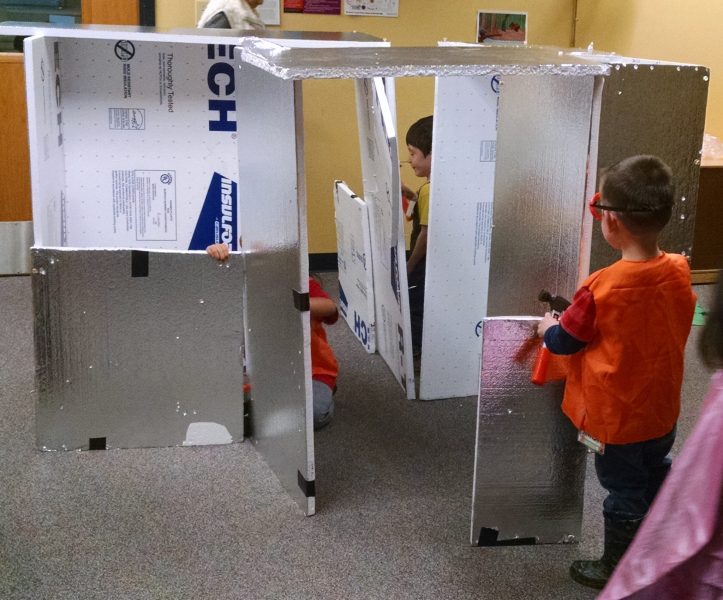
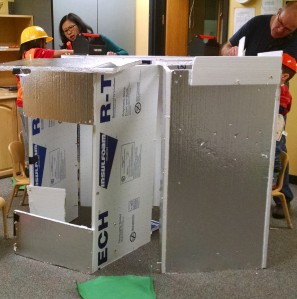




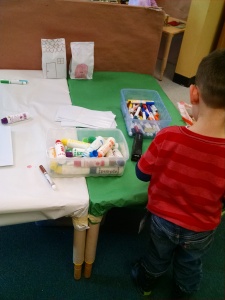
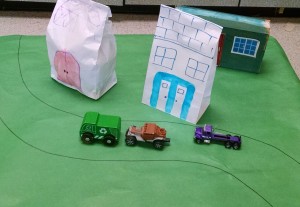
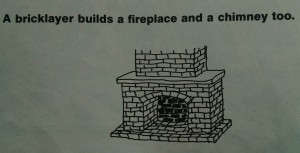
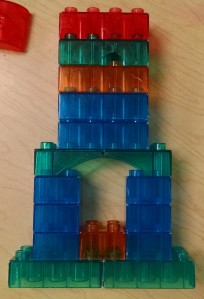
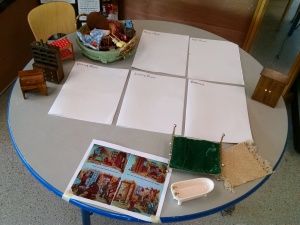
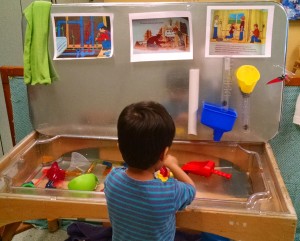
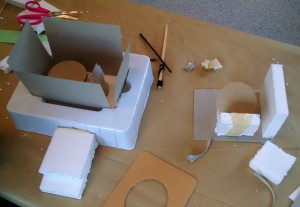
[…] maker dreams. This is probably my favorite book for my kids’ inventors class! (We read it on Build a House […]
LikeLike
[…] Time: We sang some of our favorite songs from the year (including When I Build My House), did the States of Matter dance party – pretending to be solid, liquid and gas, and blew […]
LikeLike
[…] For both this class, and our Build a House class, I want the kids to have a good quality sturdy toy hammer to play with. We’ve been […]
LikeLike